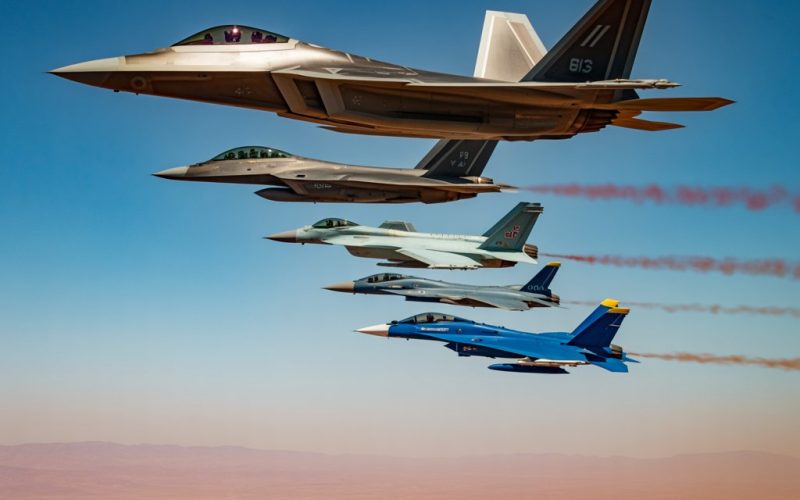Introduction
Air power has always played a decisive role in modern warfare, disaster response, and peacekeeping missions. Nations with the strongest air forces maintain a critical edge in defense, surveillance, and global influence. Here’s a look at the top air forces of the world based on technology, fleet size, training, and operational capability.
Top Air Forces of the World: Power, Technology, and Global Reach
1. United States Air Force (USAF)
The United States Air Force remains the most powerful in the world. With advanced fighter jets like the F-22 Raptor and F-35 Lightning II, strategic bombers, and cutting-edge drone technology, the USAF dominates both in numbers and innovation. Its global presence and unmatched logistics support make it the backbone of U.S. military strength.
Fleet and Technology
- The USAF operates more than 5,000 aircraft, including the F-22 Raptor and F-35 Lightning II, which are considered the most advanced stealth fighters globally.
- It fields strategic bombers like the B-2 Spirit and the upcoming B-21 Raider, designed for long-range missions and nuclear deterrence.
- Advanced drone technology (MQ-9 Reaper, RQ-170 Sentinel) enhances surveillance, intelligence gathering, and precision strikes.
Global Presence
- The USAF has bases and air wings stationed in Europe, the Middle East, Asia, and the Pacific, ensuring a strong global presence.
- Its airlift capabilities, with aircraft like the C-17 Globemaster III and C-5M Super Galaxy, allow rapid troop and equipment movement anywhere in the world.
Space and Cyber Operations
-
Through the creation of the U.S. Space Force (in 2019), the USAF plays a leading role in space defense, satellites, and cyber warfare, making it not only an air power but also a dominant force in new warfighting domains.
Training and Readiness
- The USAF invests heavily in pilot training and simulation.
- Elite units like the USAF Thunderbirds showcase precision flying, while combat pilots undergo rigorous training to maintain superiority.
2. Russian Aerospace Forces
Russia fields one of the largest air fleets in the world, with fighters such as the Su-35 and Su-57. Known for its heavy emphasis on fighter aircraft and long-range bombers, the Russian Air Force maintains a strong reputation for versatility and combat-tested capabilities.
Fleet and Technology
- Russia operates an extensive fleet, with advanced fighters like the Su-35S, MiG-35, and the fifth-generation Su-57 stealth fighter.
- It also relies heavily on strategic bombers such as the Tu-160 Blackjack (supersonic bomber), Tu-95 Bear, and Tu-22M3 Backfire, which provide long-range nuclear and conventional strike capabilities.
- The VKS deploys advanced air defense systems, most notably the S-400 and S-500, regarded as some of the most capable missile defense systems in the world.
Global and Regional Role
- The Russian Air Force has been battle-tested in multiple conflicts, including Syria, where it showcased its capabilities in long-range strikes, close air support, and electronic warfare.
- Russia maintains a strong strategic presence in Eastern Europe, Central Asia, and the Arctic, with a growing focus on expanding influence abroad.
Space and Strategic Operations
- The inclusion of aerospace defense highlights Russia’s focus on space and missile technology.
- Russia continues to invest in satellite systems, anti-satellite weapons, and advanced radar networks, ensuring its position as a major space power.
3. People’s Liberation Army Air Force (China)
The PLAAF has rapidly modernized over the past two decades. With stealth fighters like the Chengdu J-20, advanced drones, and a growing fleet of transport aircraft, China is emerging as a key air power in Asia and beyond.
Fleet and Technology
- The PLAAF operates more than 2,000 combat aircraft, making it one of the world’s largest fleets.
- Its highlight is the Chengdu J-20 “Mighty Dragon”, China’s first operational stealth fighter, designed to rival U.S. fifth-generation jets.
- Other key fighters include the Shenyang J-16, J-10C, and the heavy fighter J-11B, many of which are based on Russian designs but upgraded with Chinese technology.
- China also deploys advanced drones such as the Wing Loong and CH-series, used for both surveillance and combat missions.
Strategic Capabilities
- The PLAAF is expanding its fleet of strategic bombers, including the H-6K, which is capable of carrying cruise missiles and nuclear payloads.
- Development of the next-generation H-20 stealth bomber aims to extend China’s long-range strike capabilities, rivaling the U.S. B-2 and upcoming B-21.
Modernization and Innovation
- Over the last two decades, China has invested heavily in radar, electronic warfare, precision-guided weapons, and satellite support systems.
- Focus on domestic production has reduced reliance on foreign suppliers, allowing China to innovate rapidly.
4. Indian Air Force (IAF)
The Indian Air Force is among the top five in the world, with a powerful mix of Russian-made Sukhoi Su-30MKIs, French Rafales, and indigenous fighter programs. The IAF’s focus on modernization, combined with strong pilot training, makes it one of the most respected forces globally.
5. Royal Air Force (United Kingdom)
The RAF continues to play a crucial role in NATO operations. Equipped with Eurofighter Typhoons, F-35Bs, and advanced surveillance aircraft, the RAF combines tradition with modern capability, projecting British air power worldwide.
6. French Air and Space Force
France boasts one of Europe’s most advanced air forces, with the Dassault Rafale as its backbone. Its ability to conduct independent overseas operations, coupled with nuclear-capable aircraft, highlights its global reach.
7. Japanese Air Self-Defense Force (JASDF)
Focused on defense and regional security, the JASDF operates advanced fighters like the F-15J and F-35A. With a heavy emphasis on technology and precision, Japan maintains a formidable presence in the Asia-Pacific region.
Conclusion
Air superiority is more than just having the fastest jets; it’s about training, technology, and strategy. From the United States to Asia’s rising powers, these air forces represent the cutting edge of global defense.
As the world advances in AI, drones, and stealth technology, the race for air dominance continues to shape international security and power dynamics.












